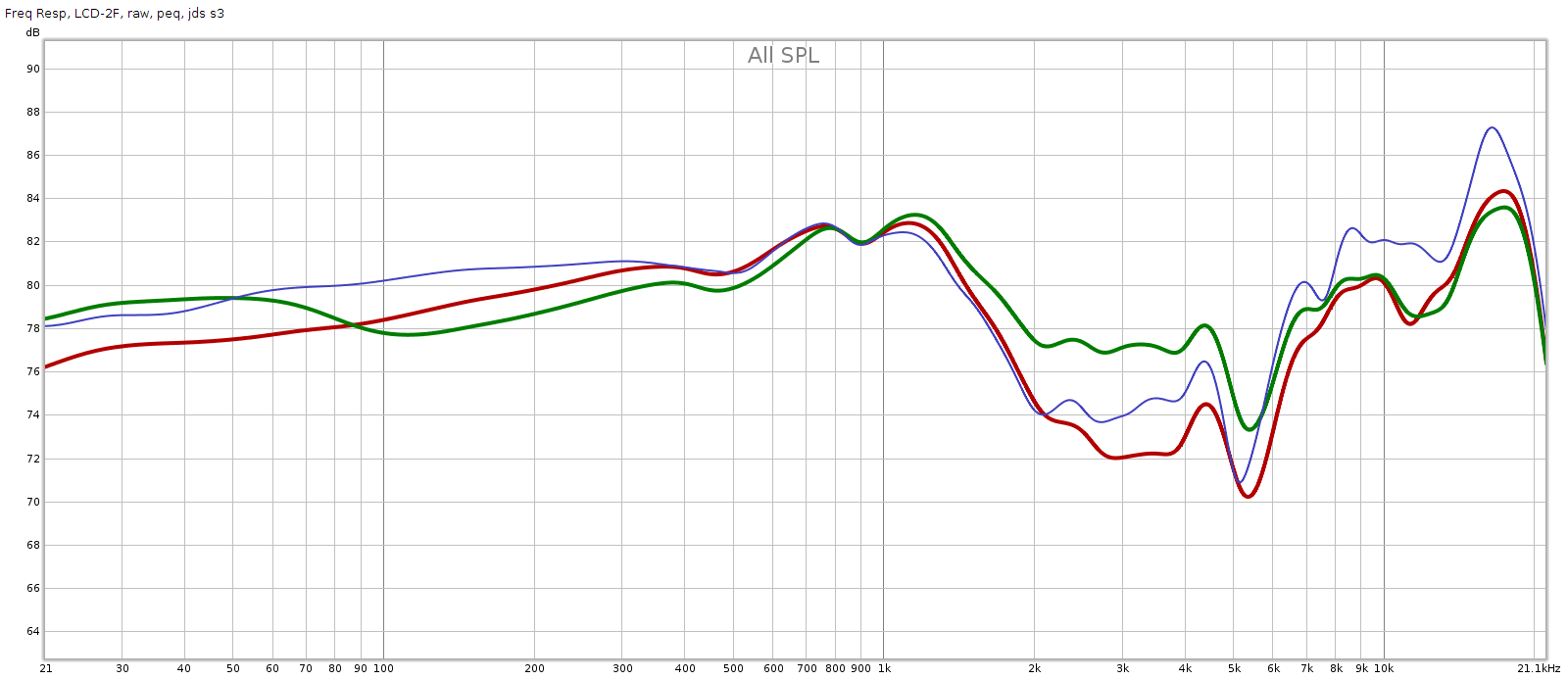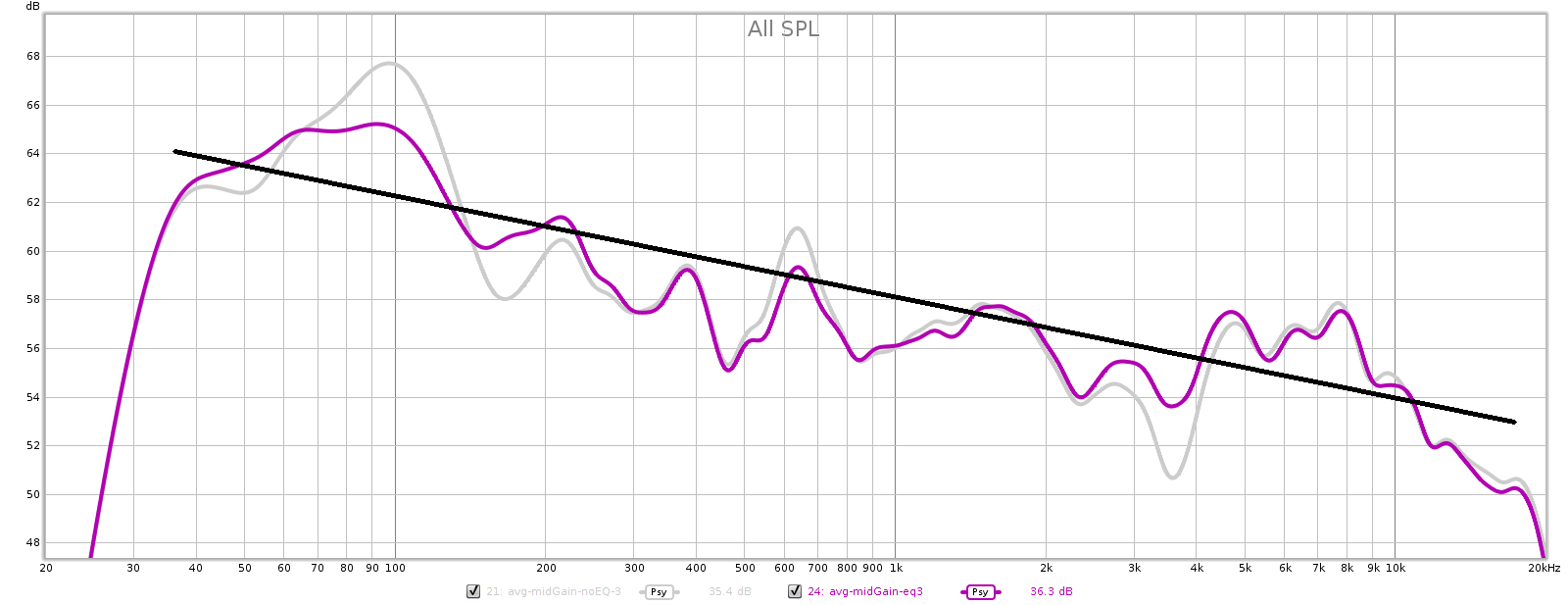Since I went to the dark side and started using EQ to correct the FR of headphones & speakers closer to neutral, I want to collect the EQ settings here. My general philosophy is to make subtle corrections. FR response deviations are often related to other forms of distortion like phase or ringing. Amplitude corrections big enough to restore completely flat response may exacerbate those other factors. Thus I stick to subtle, gentle corrections that bring it closer to neutral yet preserve the original character of the sound, short of restoring perfectly flat response.
When boosting levels, remember to apply an equal reduction in overall gain to avoid clipping. To be safe, take the biggest amplitude boost at any frequency and cut by that amount. This is in the voltage (not power) domain, so dB = 20 * log(V1/V2). That is, cutting the amplitude in half is 6 dB.
In practice you don’t need this much gain reduction; you can use 3 dB less reduction and be safe most of the time. That’s because music is never just one frequency.
For example, if you apply +2.5 dB @ 4.5 kHz, then you must reduce overall gain by 2.5 dB, which is a gain ratio of 1 / (10^(2.5/20)) = 74.98%. Or just use 74%. When it comes to gain ratio, to avoid clipping, lower is safer. So always round down (truncate the decimal). In practice in this example you can reduce gain by 2 dB less (2.5 dB – 2 dB), or only 1.5 dB and be safe most of the time.
Also, consider that boosts more than 3 dB can overwhelm the transducer, especially in the bass. You don’t want to restore linear frequency response only to have sloppy bloated sound quality. Furthermore, use parametric EQ with the most gentle slopes (broadest bandwidth) you can. The steeper the slope, the more phase distortion. The key to transparency is small corrections with gentle slopes. Don’t make the cure worse than the disease!
Updated: May 2019 with Room EQ Wizard for the speakers.
Sennheiser HD-580
Characteristic FR: flat down to 50Hz, then roll off bass at about 6 dB per octave. Gentle dip of about 5 dB between 3500 and 9000 Hz. Narrower dip of about 6 dB between 10 and 17 kHz.
Parametric EQ Correction:
- +4 dB @ 25 Hz, Q=0.67 (2 octaves wide — 1 each side)
- Gain: -2 dB = 0.794 = 79%
Subjective Difference:
This simple EQ gives the venerable HD-580 a fatter, smoother sound. Deeper bass extension without impacting mid-bass and linearity. Even though the midrange is untouched, it sounds a touch more open, less boxy overall.
Audeze LCD-2
Characteristic FR: flat from zero to about 2 kHz. Smooth dip of about 7 dB between 2k and 10k. Mostly flat again from 10k on up.
A picture’s worth 1,000 words. These are the FR curves from Audeze measured for my individual headphones (red original 2014 Fazor, black 2016 drivers).
Here’s a second opinion on frequency response measured by Tyll Herstens at Inner Fidelity:
Here’s a third measurement of FR, using the 2016 drivers, from diyaudioheaven. The LCD-2 is RED, LCD-3 PURPLE and LCD-X GREEN. The LCD-2 is the least expensive of these headphones, yet has the smoothest, most neutral response.
Here’s a 4th measurement I did myself using a MiniDSP EARS. Red is raw response, green is with parametric EQ, blue is with the JDS labs Subjective 3 mid cut (all described below).
Most measurement rigs are not accurate above 10 kHz, so those jaggies can be ignored. These curves have the same general shape, though Audeze and DIY show the dip centered at 4k and Tyll shows it at 5k. Most importantly, DIY is the most recent measurement of the latest drivers, and it shows response back up to normal levels by 8 kHz. From this I devised the following EQ:
- +6 dB @ 3350, bell, Q=0.7
- 1 octave per side; 1675 – 6700
- +2 dB @ 80, shelf, Q=1.0
- -2 dB @ 840, bell, Q=0.92
- 3/4 octave per side; 500 – 1400
- Gain: -6 dB = 0.50 = 50%
This has a broad EQ to partially correct the lower treble dip, attenuate the upper mid hump, and a gentle bass lift. It’s a gentle EQ that doesn’t change the character of the sound, but just makes it more neutral.
I’ve gone through some other similar corrections but this is the one that sounds best to my ears. Normally the LCD-2 sounds natural, yet soft like listening from the 10th instead of 1st row, and correspondingly less detailed. This EQ brings the LCD-2 back to the 2nd row restoring some lost detail, but without affecting its natural voicing.
Why only +6 dB and not +10 dB for full correction? Don’t let the cure be worse than the disease. Anything more than +6 dB sounds too bright. Take all frequency response graphs with a grain of salt and don’t try to correct every little wiggle.
When I built the JDS Labs Subjective 3, its limitations (3-band EQ) led me to a different approach to the LCD-2F: a midrange cut. Its midrange is centered around 700 Hz tapering at 100 Hz and 5 kHz respectively. Turning this down by 5-6 dB is a decent match; flattens the LCD-2F response between 100 Hz and 5 kHz while lifting the bass a touch. This is shown in the blue curve above.
Magnepan 3.6/R
Characteristic FR: depends on the room. My listening room has 4′ high tube traps 2′ diameter in corners behind the listener and the speakers, tuned bass membranes, tuned bass traps, and 4″ thick RPG acoustic foam. This weakens the room effects, smoothing the response, but the EQ still is busier than the headphones.
Making several measurements with a calibrated UMK-1 mic, Rode NT1A mics, and Room EQ Wizard, they all agreed in the bass, but showed quite a bit of variance above 300 Hz, when moving the mic only a few inches. So I took 6 different measurements, averaged them, and targeted an EQ to correct that average. The ones in bold face are room modes.
May 2020
Grey is the treated room without EQ; purple is with EQ. The black line is an ideal flat response with the standard in-room tilt.
The EQ settings:
- +3 @ 54, 1/4 octave: 43-68
- -4 @ 100, 1/2 octave: 71-141
- +4 @ 160, 1/3 octave: 127-202
- -2.5 @ 640, 1/3 octave: 508-806
- +3 @ 3597, 1/3 octave: 2855-4531
These particular settings correct deviations that were common to measurements with both mics: the UMIK-1 and Rode NT1A.
May 2019:
- +5 @ 64, 1/2 octave: 45-90
- -1 @ 120, 1/2 octave: 85-170
- -1 @ 302, 1/5 octave: 263-347
- -3 @ 760, 3/4 octave: 452-1278
- -2 @ 1023, 1/6 octave: 911-1148
- -2 @ 8433, 1/3 octave: 6693-10625
With these settings, the Maggies drop 1 dB per octave from 35 Hz to 20 kHz, and they measure within 2 dB of flat along this line. I weakened a bass null with GIK Scopus T70 tuned bass membranes and added Realtraps Megatraps to control the room’s 100 Hz bump. Measurements show these work as advertised, so I recommend them. And my home-made tube traps provide broadband bass damping, improving transient response and spectral decay. The bass rolls off below 35 hz, but deep bass is still there and 25 Hz is audible.




